Tell readers what you’re going to tell ’em
If I came to your house and told you to grab your things and follow me, how far would you go? To the front door? The driveway? Would you hop in my car without further explanation?
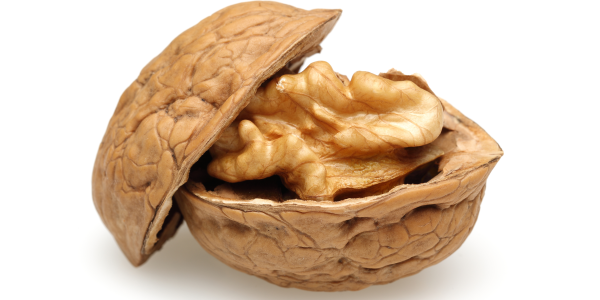
No matter how dazzling your scene-setting feature lead, at some point, readers want to know where we’re going with this story. And that’s the job of the nut paragraph, aka the nut graf. (This, by the way, is the nut graph for this story.)
The nut graph is the transition from the lead. In the nut graph, writers and editors:
- Explain the lead and its connection to the rest of the story
- Reveal your destination, or the essential theme of the story
- Set up the supporting material to explain the rest of the story
- Explain why the story is important to convince your readers to come along for the ride
You don’t need a nut graph in news stories, but they’re essential in feature-style stories.
Let’s pause and ponder that for a minute too.
Here are four ways to crack the nut graph:
1. Tell ’em what you’re going to tell ’em.
Remember the old writing guideline, “Tell ’em what you’re going to tell ’em; tell ’em; then tell ’em what you told ’em?”
The nut graph is where you tell ’em what you’re going to tell ’em.
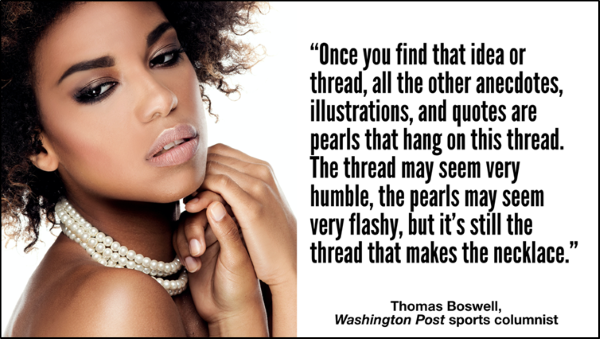
The nut graph — aka the “billboard” or the “so-what graph” — is where you put the story into a nutshell. It explains why the story is timely and provides the kernel, or central theme, of your piece.
“Once you find that idea or thread, all the other anecdotes, illustrations, and quotes are pearls that hang on this thread,” says Thomas Boswell, a Washington Post sports columnist. “The thread may seem very humble, the pearls may seem very flashy, but it’s still the thread that makes the necklace.”
So the first step to writing a nut graph is to find that thread. In other words, you need to figure out your point, or story angle.
2. Summarize your story angle in one sentence.
One of my J-school professors used to say, “If you can’t write your story angle on the back of my business card, you don’t know what your story’s about yet.”

To figure out what your story is about, write a one-sentence walkaway. That’s the one sentence you want your reader to — you got it! — walk away with after reading your piece. Then craft that so tightly that it will fit on the back of a business card:
Your walkaway sentence should answer the readers’ two most burning questions:
- What’s your point?
- Why should I care?
Stuck? Try telling a friend who knows nothing about the story what it’s about. Then capture that summary for your nut graph.
Start every writing project with a one-sentence walkaway. It will help you figure what goes in, what stays out and how to frame your story. You might even tape it to your computer screen to keep it top of mind while you write.
3. Make a promise to your readers.
At The Philadelphia Inquirer, the nut graph is known as the “You may be wondering why we invited you to this party” section, writes Chip Scanlan, affiliate faculty member at The Poynter Institute.
It’s also known as the R.A. paragraph, says Don Ranly, Ph.D., professor of journalism at the Missouri School of Journalism. That’s as in “rat’s ass,” as in “Who gives a rat’s ass about this story?”
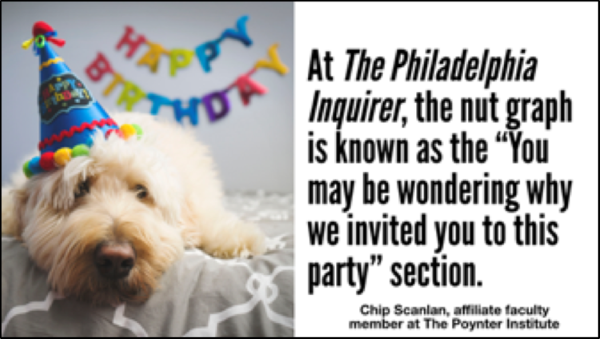
The nut graph — aka the “so-what graph” — shows readers where the story is heading so they can decide whether they want to follow along. The nut graph is where you make a promise to your readers: If you read this, you will learn …
So tell readers why it’s important for them to read this story now. Don’t drop the “Why should I care?” angle of the story. The nut graph is a great place for a WIIFM or a reader benefit. Stuck? Try starting your walkaway sentence with You.
Make sure someone gives a rat’s ass. Want to grab readers’ attention? Start with a dazzling feature lead. But if you want them to follow you throughout the story, follow up with a solid nut graph.
4. Keep it short.
Don’t let your nut graph become the pig in the snake, counsels Jacqui Banaszynski.
“I like the nut graph,” says the Knight Chair in Editing at the Missouri School of Journalism and visiting faculty member of The Poynter Institute.
“Readers need a frame around the picture. But sometimes the nut graph sticks out like a pig going through a snake. The nut graph doesn’t have to be a paragraph. Instead, it can be one elegant line that foreshadows the rest of the story.”
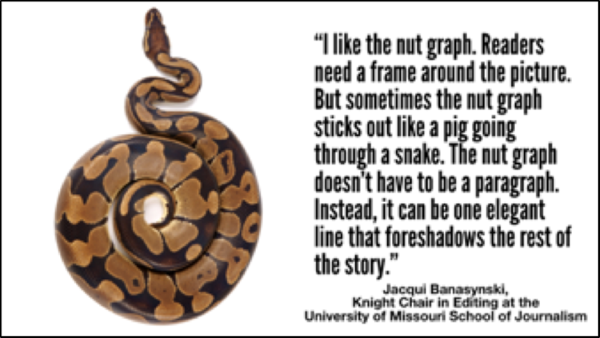
Roy Peter Clark, vice president and senior scholar of The Poynter Institute, agrees: “The ‘nut’ is supposed to signify the hard kernel of the story, what is at the center. But it’s a clumsy metaphor, because it suggests there is a shell that has to be cracked to get to it.”
That’s no fun for the reader, writes Kate Long, a writing coach for The Charleston Gazette: “You’re eating this nice brownie, and suddenly you hit a chunk of dry flour.”
To keep your reader from choking on your nut graph, write a short, graceful summary that’s in keeping with the tone and style of the rest of your piece.
Summarize your point in a sentence or two. That’s all you need for a nut graph.
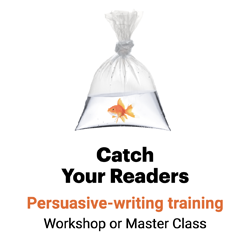
Leave a Reply